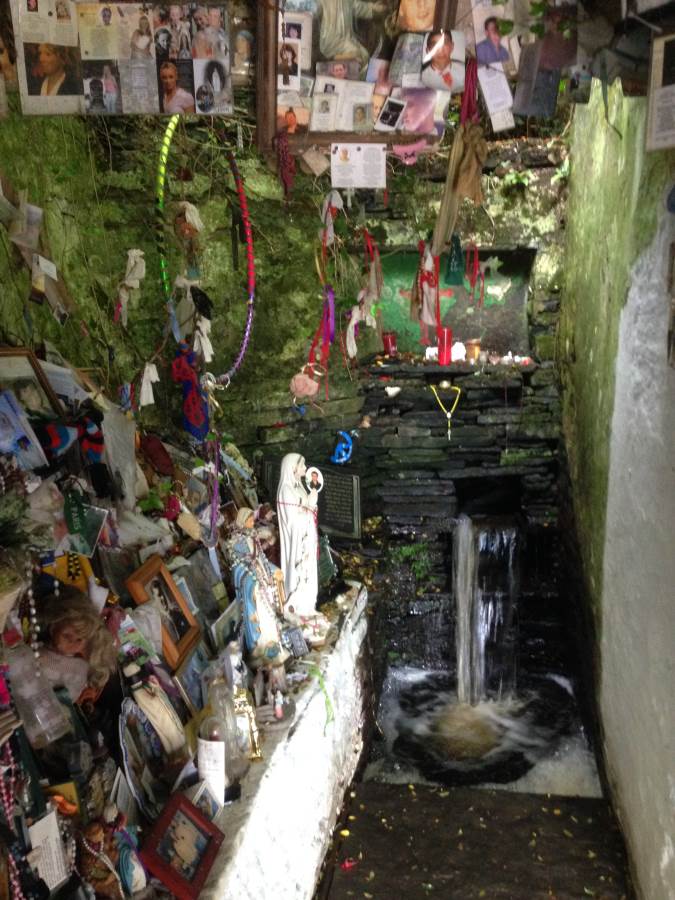
A short tour of County Meath and County Clare, playing music whenever we can and assisting with making a short film about Holy Wells and the (almost) lost custom of Keening. We might encounter the people of the Sidhe, and the Banshee might not be far away.
I will be visiting the County Archives Office in Ennis, Co. Clare, donating papers from my Great Great Grandfather, Philip Dwyer, to add to the exhibition about him at the County Library. The collection gives a vivid portrait of family life of the period, – split by emigration, the changing role of women and the effects of political events. Philip Dwyer was the main force behind the building of St Columba’s Church, Ennis, and is also known as The Historian of Clare. His major work a was A History of the Diocese of Killaloe.
Holy Wells
The history surrounding Holy Wells is long and complex, and there is evidence that some activities around them pre-date the Christian Era. Ireland has many thousands of these sites and they have held a special place in the hearts of their communities up until the present day. The range of activities surrounding the wells is too great to describe in detail here, but the following can be included with some certainty:
- Healing and cures, particularly for the eyes.
- Pilgrimage on fixed days of the year, often in families.
- Rituals of prayer and procession round the well.
- Bare feet and walking on the knees
- Drinking water from the well
- Collecting earth and clay from the site
- All night vigils beside the well.
- Large crowds
- Heavy drinking of alcohol
- Mass fighting, sometimes with severe injuries
- Honouring of trees beside the well, particularly whitethorn, hazel and ash
- Leaving tokens on an altar or tied to a tree by the well
- Worship of stones including:
- Marked stones
- Curing stones
- Swearing stones
- Cursing stones
- Stones with holes
- Stones with cup marks
- Adding a stone to a heap
- Kissing a stone
- Baptism and Christian worship
- Prayers for the dead
- Offerings of coins, statues, crucifix, more recently photographs.
- Purification by washing in water taken from the well.
- Naked mixed bathing in nearby steams or in the sea, to the dismay of the priest.
- Baptism of infants.
Although many wells are now overgrown and hard to find, hundreds are regularly maintained by community volunteers, who cut the grass, repair footpaths and fences, and repaint wooden and stone structures. Many are on private land, away from main roads.
Faction Fighting and Mass Brawls
Googling ‘Faction Fight’ will reveal a mass of information about this ritualised combat associted with Holy Wells. Just one example here: https://irishfolklore.wordpress.com/…/irish-stick…/
Keening
Keening is the practice of improvised chanting, sometimes described as wailing, beside the body of a dead person at a funeral wake. Usually done by women, some of whom were ‘professional’ (i.e. they were paid for their services) but keening by men was not unknown. Keening was strongly condemned by the Christian church, and was suppressed before recording technology was available. There are no known recordings of keening at a wake, although it has been recreated from descriptions. It is generally agreed that keening did not follow any kind of set text or fixed words, but the singer improvised a melody on a few common themes, as they felt it at the time.
Check out this example, sung by Joe Heaney, (born 1919) It is a smooth and polished performance, without the raw emotion of a lament at a wake, but it gives a good idea of the style.
This beautiful song (The Song of Muinish by the wonderful Líadan) is not keening, but sung in the ‘sean nos’ style, with elaborate runs and ornaments. It is sung by an old woman, contemplating her death, and planning her wake. It is one of the most lovely lyrics and melodies I know, although I know it only in English. Listen here: https://www.youtube.com/watch?v=By0QM8mlr28
If I have my children home with me the night that I will die,
They will wake me in mighty style three nights and three days;
There will be fine clay pipes and kegs that are full,
And there will be three mountainy women to keen me when I’m laid out.
Road Trip – Itinerary
We travel from Dublin to Cavan, via several sites in the Boyne Valley. From there we travel to Ennis via to Ballyvaughan and Doolin – which both have Holy Wells nearby, as well as music sessions… We will be based in West Clare for about 3 days. Provisional itinerary of our trip on Google Maps here:
Images

Tying rags to trees as votive offerings is not uncommon:



